Monthly economic brief: February 2021
The monthly economic brief provides a summary of latest key economic statistics, forecasts and analysis on the Scottish economy.
Labour Market
Unemployment remained low by historical standards in November, supported by the Job Retention Scheme, however wider labour market indicators signal challenging labour market conditions.
Coronavirus Jobs Retention Scheme (CJRS) and Self Employment Income Support Scheme[9]
- The CJRS has been supporting the retention of jobs and incomes since March, during the national lockdown phase, as restrictions were relaxed in the third quarter, and has been extended to the end of April 2021, reflecting the restrictions that have been in place at the end of 2020 and into the new year.
- At the end of December, 282,800 employments (11% of eligible employments) in Scotland were furloughed.
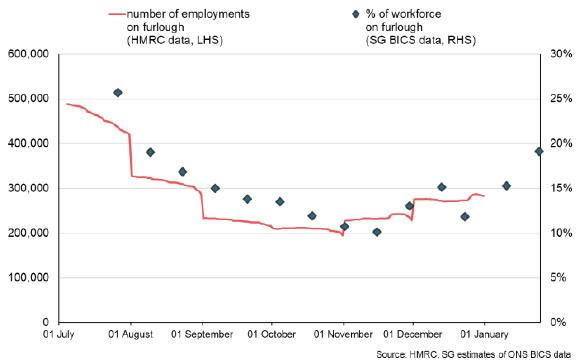
- This is lower than the 421,200 employments (17%) furloughed at the end of July, however has risen from the low of 195,200 (8%) at the end of October and 228,300 (9%) at the end of November as take-up has increased as restrictions have been re-introduced.
- The sectors with the highest number of employments furloughed across Scotland were Accommodation and food services (83,200, 30% of all employments furloughed in Scotland), Wholesale and retail (50,000, 18%) and Arts, entertainment and recreation (25,400, 9%).
- More recent Scottish Government ONS BICS data suggests the furlough take-up rate continued to increase in January with an estimated 61% of businesses in Scotland having staff on furlough (up from 49% in December), supporting 19% of the workforce (up from 12% in December).[10]
Take-up rate of 3rd SEISS grant by Sector in Scotland
(up to 31 December)
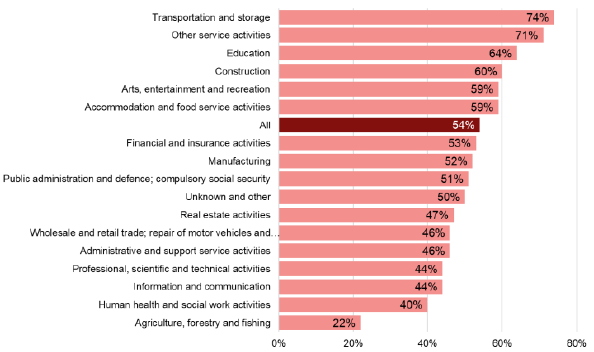
- The Self Employed Income Support Scheme (SEISS) has also continued to provide critical support to the labour market with the third SEISS grant opening on 30 November. By the end of December, 112,000 claims in Scotland had been made to the third SEISS. This represents 54% of the eligible population, with an average claim of £2,800. By sector, take-up rate was highest for Transportation and Storage (74%), other service activities (71%), Education (64%) and Construction (60%).
Measuring the labour market during the pandemic
The pandemic has had a significant impact on the labour market with many people unable to work as normal due to restrictions imposed to supress the spread of COVID-19. In some sectors, people have been able to continue to work, either in their usual workplace with mitigation measures, or by working from home. Other sectors, particularly those with face-to face customer interaction, such as accommodation and hospitality and retail, have had less flexibility and have been impacted to a greater degree. Many of these affected jobs have been protected by the furlough scheme. However, some businesses have closed permanently as a result of the pandemic, and not everyone has been eligible for the support schemes.
Understanding the impact of the pandemic on the labour market is crucial in order to provide the necessary support to workers. The official source of estimates of employment and unemployment levels and rates is the Labour Force Survey (LFS). These have remained relatively stable since February, which in part reflects the impact of support schemes.
However, in the latest Labour Market statistics, the ONS also noted that due to the uncertainty caused by the pandemic, the levels of employment and unemployment and changes in those levels, should be used with caution; although they do stress that overall headline rates remain robust and reliable. As well as the LFS, there are a number of other data sources that provide insights into the labour market and which can be more timely.
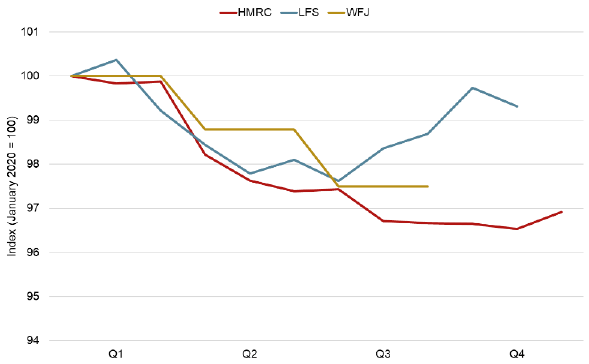
HMRC’s Pay as You Earn Real Time Information system provides information on the number of payrolled employees across the UK, and the quarterly Workforce Jobs Survey (WFJ) directly asks businesses how many staff they employ. While all the measures had been broadly similar in the initial impact of the pandemic, they have shown some divergence in recent months.
The LFS suggests that overall employment in Scotland has recovered to pre‑pandemic levels, whilst HMRC data, and to a degree the Workforce Jobs Survey (WFJ), which is quarterly, suggest that employment levels remain lower. Lower employment levels are also consistent with results from claimant count data showing a significant rise in people claiming for unemployment related benefits.
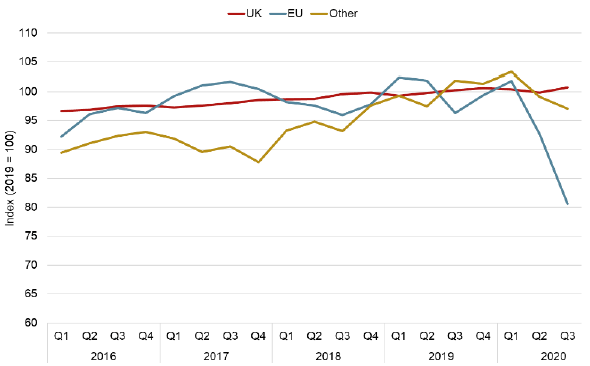
Part of the explanation for the potential divergence between the LFS and other indicators may be the impact of migration. This has been raised recently by a recent publication from the Economic Statistics Centre of Excellence. This highlights that the LFS assumes that there has been no significant change in the UK population during the pandemic, but presents research suggesting that the UK has experienced a degree of net outward-migration.[11] This may also be reflected in survey data that shows that the number of EU nationals in employment has fallen faster than other nationalities.
The ONS are currently reviewing the population totals used in the LFS. Were changes to be made, the current LFS employment and unemployment figures could potentially be revised in future. Hence a degree of caution may be required in currently putting too much emphasis on one source of labour market data when interpreting the current impacts of the pandemic.
Official labour market statistics
- The latest labour market statistics cover the period September to November when national lockdown restrictions had been eased, but regional restrictions started to be introduced from October and businesses continued to receive support through the CJRS and SEISS.
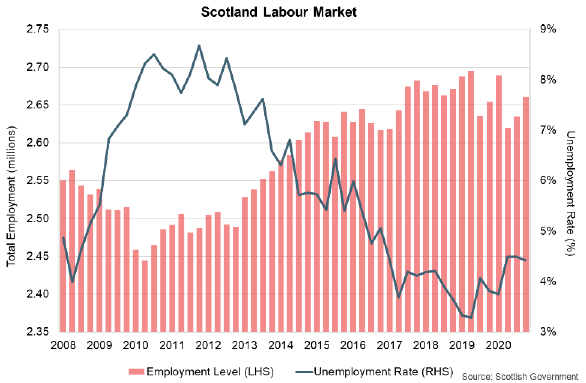
- Over the quarter to September to November,[12] the employment rate increased 0.5 percentage points to 74.4% (UK: 75.2%), while the unemployment rate fell 0.1% percentage points to 4.4% (UK: 5.0%) and the inactivity rate fell 0.5 percentage points to 22.1% (UK: 20.7%).
- The headline labour market indicators only show a partial picture of the labour market as people on furlough are considered employed. Wider labour market indicators show challenges that have been emerging in the labour market during the pandemic.
PAYE payrolled employment
- The more timely Pay As You Earn (PAYE) Real Time Information data show that the number of payrolled employees in Scotland (2.33 million) and the UK as a whole (28.2 million) has fallen sharply in 2020.
Number of payrolled employees
(Jul 2014 - Dec 2020)
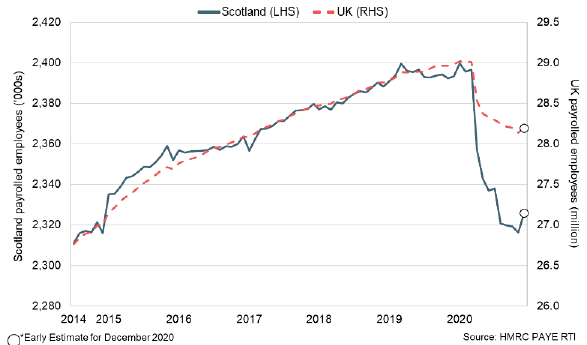
- Over the month from November, payrolled employees increased by c.9,000 (0.4%) in Scotland (UK: 0.2%). However, compared to February 2020, the number of payrolled employees has fallen c. 70,000 (-2.9%) in Scotland (UK: -2.9%).[13]
Claimant Count
- Scotland’s Claimant Count (the number of claimants of Job Seekers Allowance and claimants of Universal Credit claiming principally for the reason of being unemployed) was 210,800 in December and had decreased by 1,400 (0.6%) over the month.
Claimant Count in Scotland
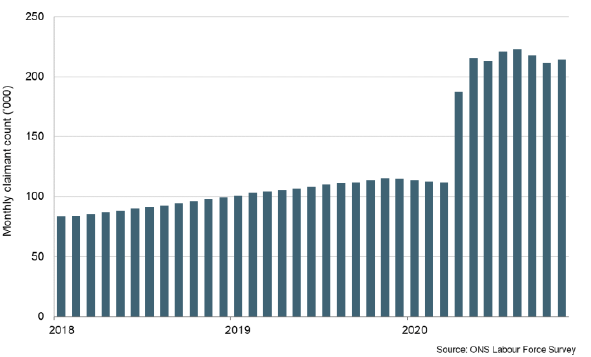
- However, while the claimant count has been relatively stable since May, it remains 88% higher than in February (prior to the impacts of the pandemic), signalling that the number of people that are unemployed or employed with low income and/or low hours has increased significantly during 2020.[14]
Demand for staff in Scotland
- The IHS Markit RBS Report on Jobs survey for December showed a mixed picture for recruitment activity with permanent job placements continuing to fall while temporary placements increased.[15]
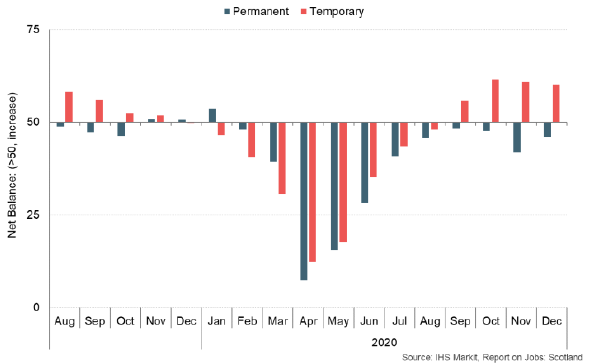
- The fall in permanent job placements in December was more moderate than in November. In contrast, temporary job placements increased for a fourth month indicating that where companies are recruiting, they are favouring more flexible recruitment through temporary staff amid the restrictions on activity.
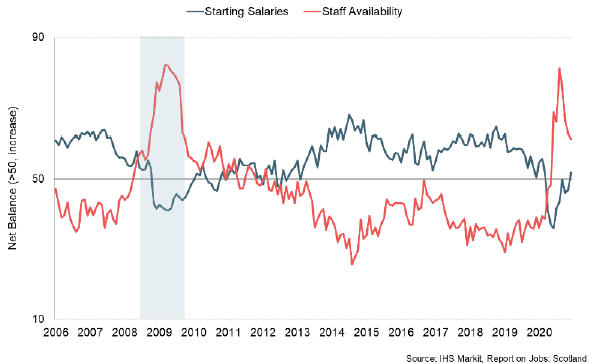
- While hiring activity remained subdued overall, staff availability (labour supply) continued to increase in December, though at its slowest pace since May, with respondents continuing to link the increase in job seekers to job losses and redundancies. Alongside this, starting salaries in Scotland increased in December for the first time since March. The growth in starting salaries was marginal overall, however was notably stronger for temporary staff than permanent.
Earnings
- More broadly on earnings, despite the protection offered to the labour market through the furlough scheme, earnings fell at the beginning of the pandemic. Between March and June, PAYE mean monthly pay fell for four consecutive months compared to the previous year. It returned to growth in July, and strengthened through the third quarter. Latest data for November, suggests the rate of growth has stabilised over October and November. Mean monthly pay in November was £2,441, a 4.4% increase from November 2019, while UK annual growth continued to accelerate to 5.7%.[16]
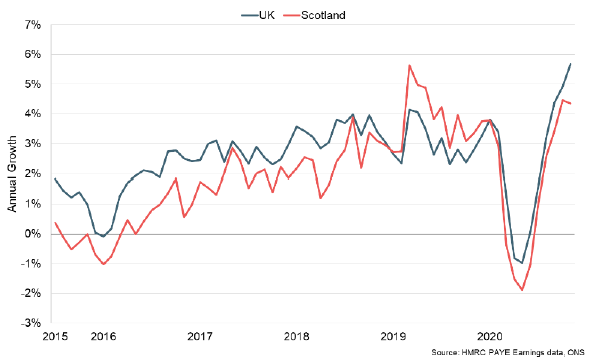
- While the mean annual earnings growth rate has rebounded in the second half of 2020, the picture is complex and caution needs to be used in interpreting the figures, particularly in light of the fall in the number of payrolled employees. There are compositional effects (e.g. by sector and across income levels) underlying the data which suggest that not all parts of the labour market have experienced the same rebound as the mean rate implies.
Contact
Email: OCEABusiness@gov.scot
There is a problem
Thanks for your feedback